Feature STORY

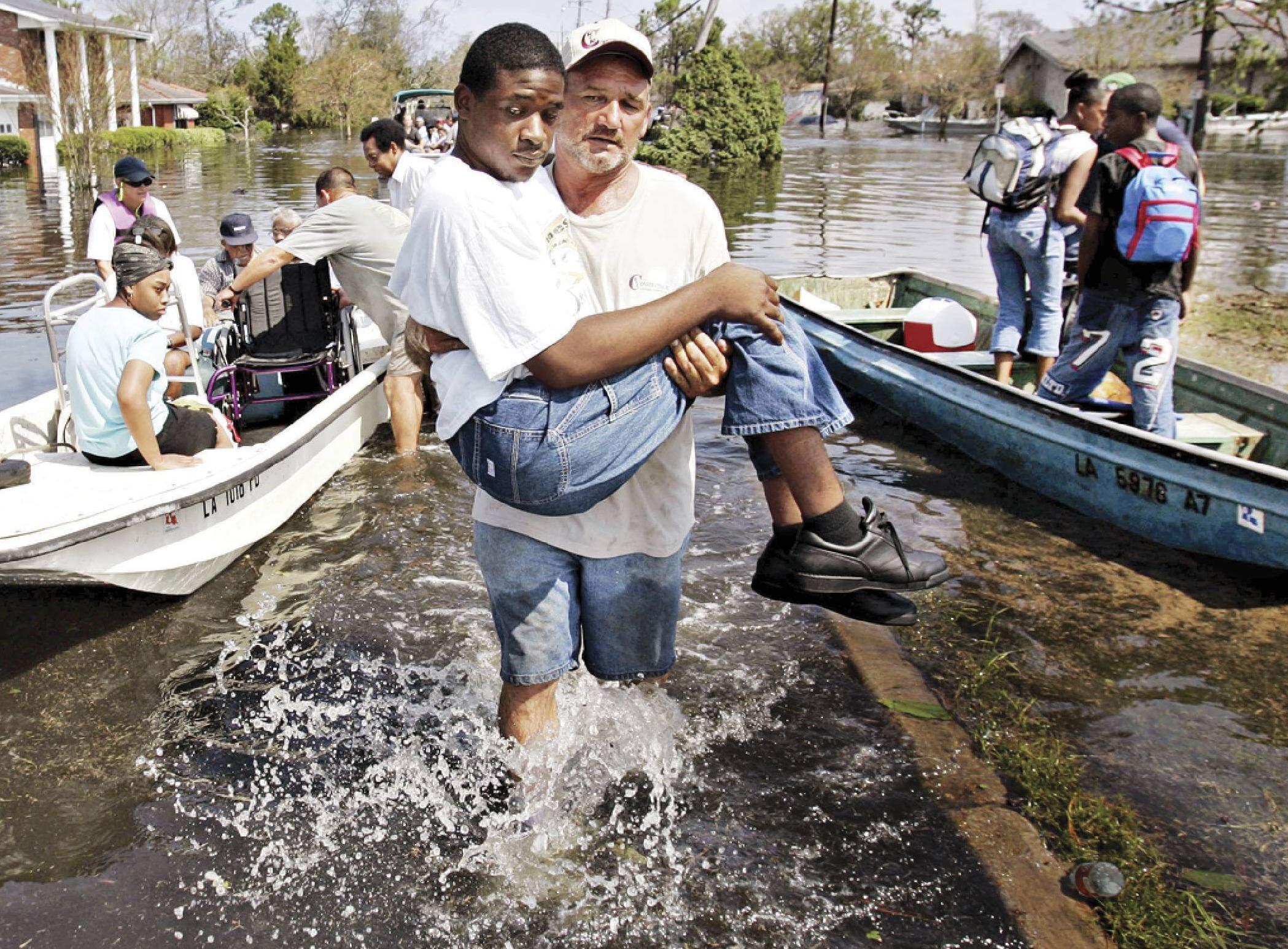
United Cajun Navy volunteer Mickey Monceaux offering aid in 2005
IN NEW ORLEANS, longtime residents once sat on their porches and waved the weather forecasters along, certain the Mississippi would mind its manners. They’d seen so many “storms of the century” come and go, there was a kind of local pride in “ridin’ things out.” If you’d weathered Betsy in 1965 and other big blows, the generational wisdom boiled down to a shrugged “We’ve been through worse.”
Then came Katrina. When the levees failed on August 29, 2005, nearly 80 percent of New Orleans was submerged, making it one of the costliest residential disasters in U.S. history. In Louisiana alone, Katrina claimed at least 986 lives—although some estimates place the toll closer to 1,300. More than 200,000 jobs disappeared almost overnight. In many ways, older adults suffered the most. Though those 75 and older made up just 6 percent of the city’s population, they accounted for more than half of all lives lost.
I arrived in New Orleans a couple of months after the storm to cover the early stages of recovery. The city was in shambles. Street signs hung sideways. Homes were spray-painted with rescue codes. I’ll never forget the rancid smell, or the heavy air of grief. But even then, resilience was rising; I felt a pulse, faint but steady. Now, 20 years on, I’ve returned—not only to remember but to ask: What did people do with the years since Katrina? What does it take to start over? How do you rebuild when your old life isn’t coming back?
You still see vacant lots and boarded-up homes. Roads and drainage systems are under strain. Poverty and crime remain top concerns. But in ways both visible and quietly profound, Katrina pushed people with experience—even the seen-it-all types—into new territory. In the wreckage, many found space for something else to take root.

Todd Terrell has turned United Cajun Navy into a national disaster relief group.
When Rescue Comes by Boat and Bravery
“We’d shine a flashlight through the window, and you’d just see these eyes staring back at you in terror.”
Todd Terrell, 58, founder of the United Cajun Navy
TODD TERRELL talks like a man with three other places to be. Over the course of our conversation, his phone dinged 11 times with updates from his lieutenants: a fundraising fish fry in Baton Rouge, tornado strikes in Tennessee, swift-water training exercises in North Carolina. If he comes across like a general without a uniform, that’s about right. Terrell’s the head of the United Cajun Navy.
Twenty years ago, Terrell was working for his family’s seafood business in New Orleans when Katrina knocked out a couple of their processing plants around Lake Pontchartrain. “It was terrible,” he says. “No roads, water everywhere, and nobody was coming in to help. I grabbed a boat, and I think I slept two or three hours over the next five nights.” Terrell and the ragtag crew of volunteers he assembled—veterans, shrimpers, bikers, Sunday school teachers—braved raging waters, snakes and gunfire to pluck people off branches, ferry residents from nursing homes and follow whatever path a scratchy CB call or scribbled map might reveal. “There was this one woman, must’ve been 85,” Terrell recalls. “She was sitting on her porch with water up to her knees, holding a Bible in one hand and her medication in the other. Said she’d been praying for a boat.”
What began as an act of desperation became a calling. Today, United Cajun Navy is a national disaster relief group that rushes in when others pack up. Its focus is on those overlooked—most often older people. They knock on trailer doors, check on isolated grandparents after blackouts and quietly stock underserved nursing homes with hygiene kits, socks and warm blankets.
“You’d be surprised how many older folks just need someone to knock and say, ‘Hey, you OK?’ ” Terrell says.

Robert Green on the steps of his old home
Remembering the Roof Riders
“You can’t let what happened hold on to you, because there’s always hope.”
Robert Lynn Green Sr., 70, founding member, Roof Riders
“WE DIDN’T expect 25 feet of water, and we definitely didn’t think our house would start floating away,” Robert Lynn Green Sr. says. But there they were—Green and his three grandkids (ages 2, 3 and 4), his brother, his cousin who had an intellectual disability, and his ailing 73-year-old mother—bobbing through the Lower 9th Ward at 4 a.m. atop their World War II–era house, “praying to God this hell ride would stop.” It didn’t. Tragically, the 3-year-old fell off the roof to her death. Green’s mother also perished.
“I cried so hard the first time I told the story, and the second and 50th time too,” Green tells me. “But now I’ve told it a thousand times, and the tears don’t come. Now I celebrate life.”
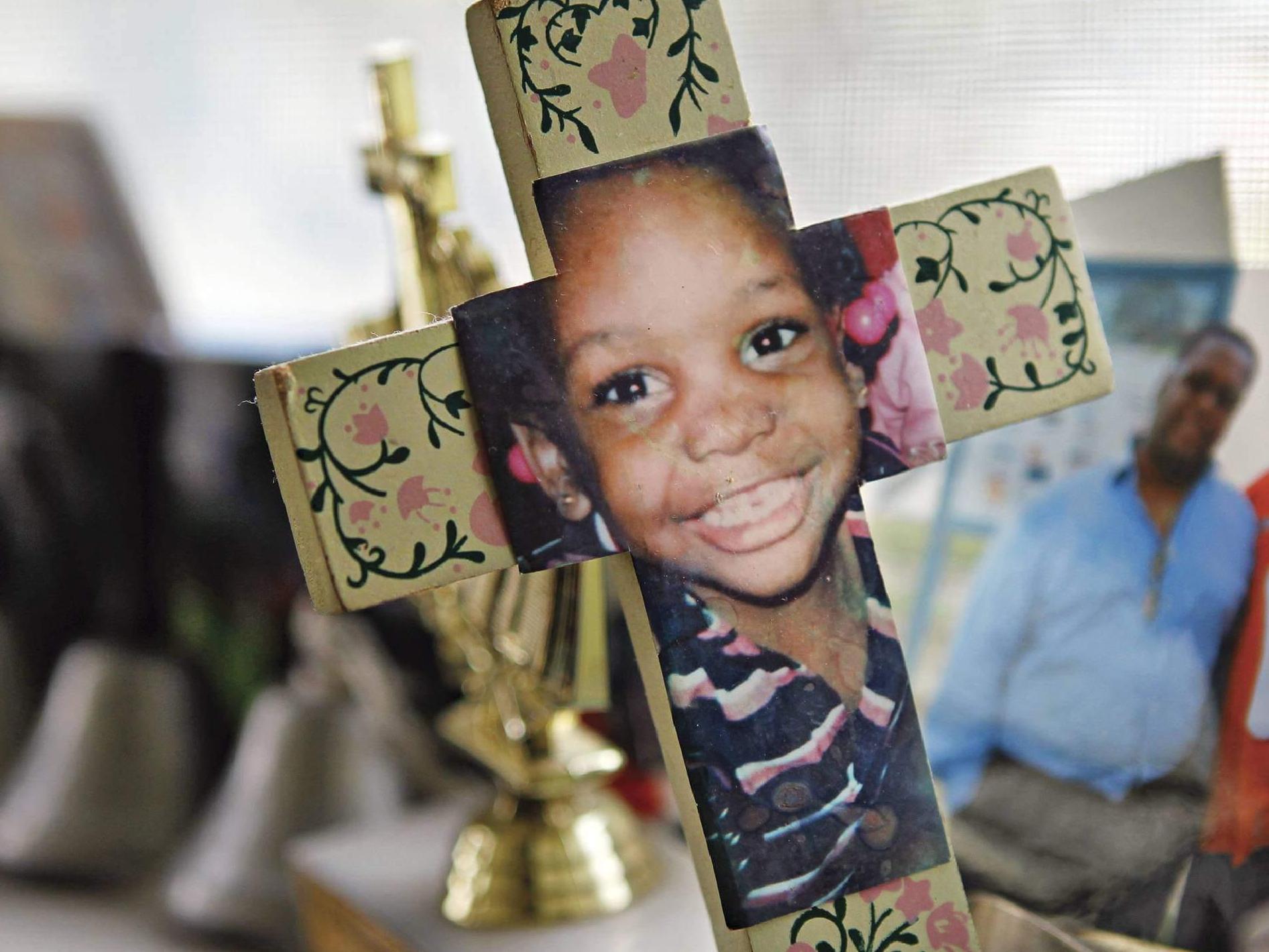
Green’s late granddaughter, Shanai
That resilience and resolve made Green, a semiretired tax accountant, something of a local hero when he was among the first to move back to what he calls “the wilderness” of wreckage and emptiness that defined the Lower 9th. When “disaster tours” started rolling through the neighborhood mere weeks after the storm, Green didn’t seethe like many of his neighbors. He stopped and talked to people. “I wanted everyone to know what happened,” he says.
And he rebuilt. After Katrina, Green lived in a FEMA trailer beside the ruins of his home, featuring two memorial markers and a sign that read “Roots Run Deep Here.” Eventually, he moved into a new house built on the same lot—one of the first to go up after the storm.

Flood damage in New Orleans
On August 29 each year for the past 20 years, Green and his family and neighbors, all in shirts that read “The Original Roof Riders,” mark Katrina’s anniversary with a walk from the spot on Tennessee Street where his family house came off its foundation to the large oak tree a few blocks away where it came to rest. There, they read aloud the names of those who died in the storm. A booming bass drum and wailing trumpets make sure grief doesn’t get the last word.
“When you lose something, it doesn’t have to define you,” Green says. “You’re alive? You’re winning.”
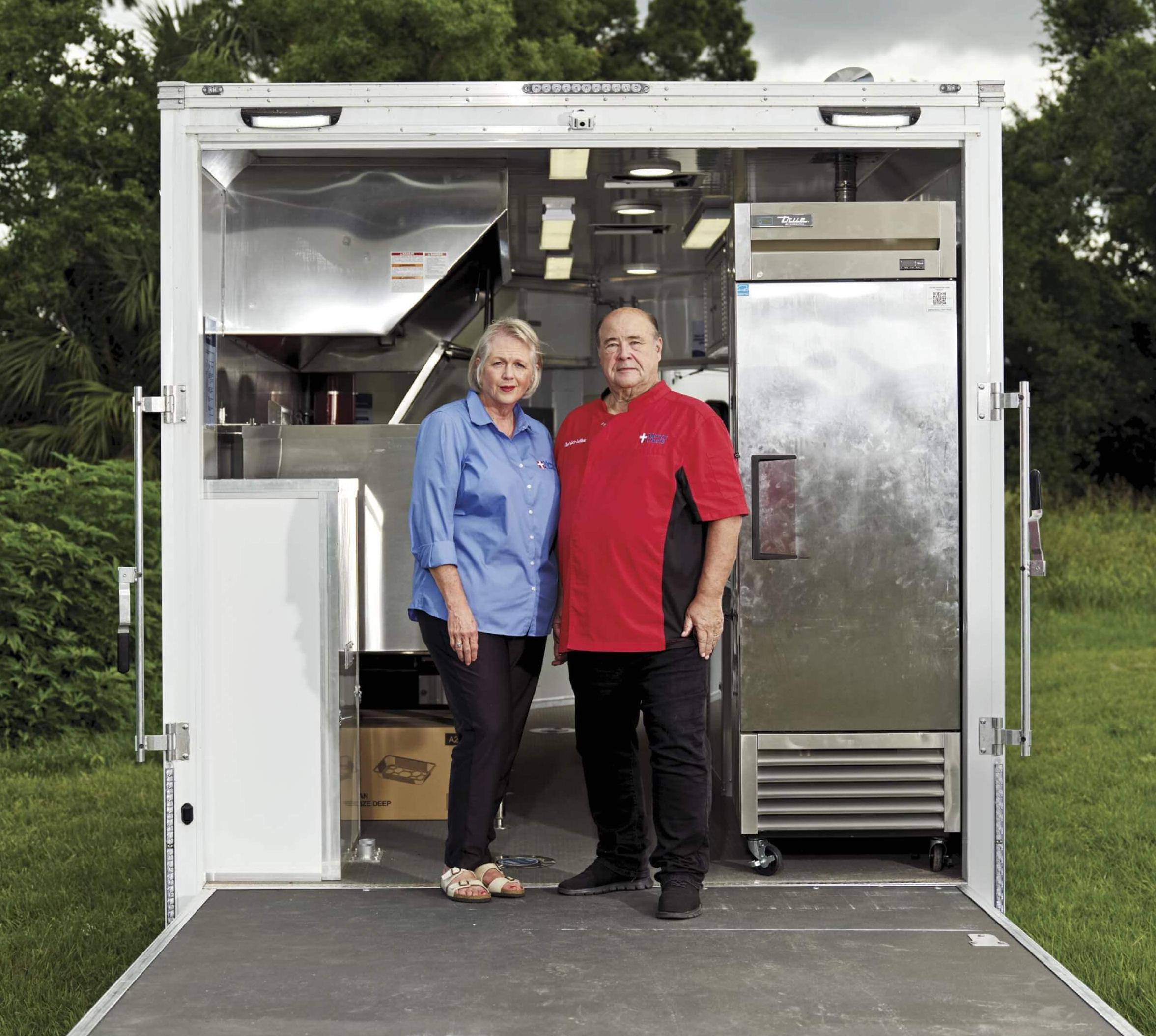
Ann and Gary LeBlanc, in one of Mercy Chefs’ mobile kitchens
Serving Humanity One Hot Meal at a Time
“Disaster food should taste like love.”
Gary LeBlanc, 69, and Ann LeBlanc, 62, owners, Mercy Chefs
A HOTEL group manager working in Virginia, Gary LeBlanc watched helplessly as flooding swallowed the streets of his beloved hometown. On the TV screen, he recognized familiar intersections and even a few faces on the highway overpasses. He knew he had to get in the car and start driving: LeBlanc’s adult daughter was safe, but her house in New Orleans East was under 7 feet of water. His grandmother, who’d evacuated to stay with a relative, had fallen in the dark and broken her hip. She would never recover.
“I certainly couldn’t fix everything,” LeBlanc tells me. “But I could cook. So that’s what I did.”
When he finally made it to New Orleans 48 hours later, what he saw shocked him. At makeshift relief centers, people were being handed cold green beans straight from the can. “It was the worst week of their lives,” he says. “And we were feeding them like they didn’t matter. Food kept them alive, OK—but it didn’t help them feel human.”
A couple of weeks later, back in Virginia, he stayed up late filling legal pads with ideas: hot meals, made by real chefs, served with compassion. When no relief organization would take him seriously about launching an operation of that sort, he started his own. Nine months after Katrina, Mercy Chefs was born.
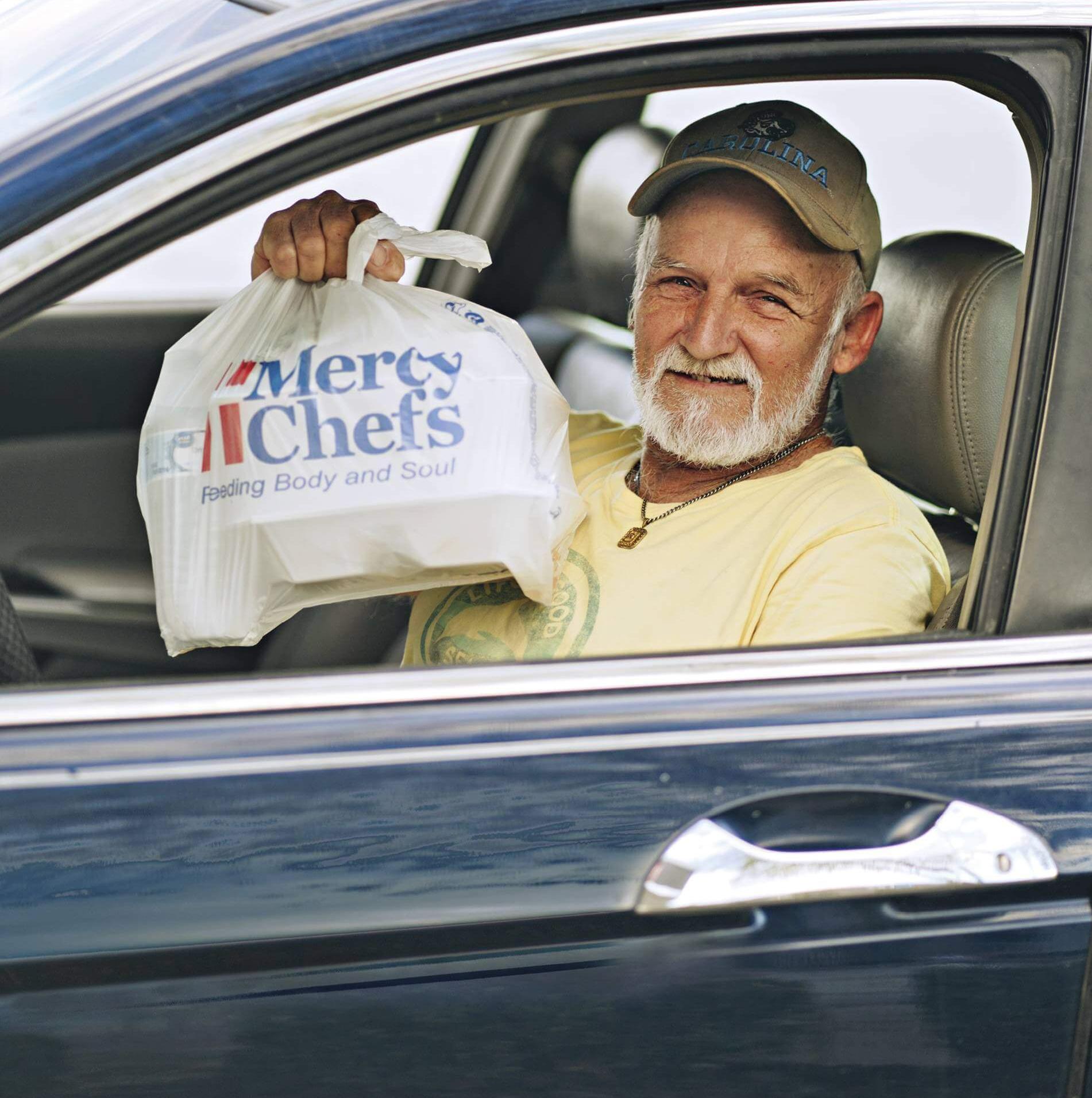
A grateful Hurricane Helene (2024) customer
I spoke with Gary and his wife, Ann, who now run the nonprofit together. You’d never guess, from the way they downplay it, that they’ve fed more people than some countries hold. Mercy Chefs has served more than 29 million meals—grilled chicken, jambalaya, made-from-scratch casseroles—to survivors, first responders and displaced families in nearly every major U.S. disaster since Katrina. But they tell me the work with older adults matters the most.
“They’re often stranded, isolated and forgotten,” Gary says. “And they can’t always come to you. You have to go to them.”
During disasters, the team seeks out senior housing where elevators are stalled, power is out and residents might be stranded. They bring meals—but also routine, recognition and calm. “As you age, the little things really matter,” Ann says. “We try to be the opposite of abandonment.”
Their work doesn’t end after that initial push. Mercy Chefs helps build community kitchens, restock pantries and create grocery programs for families long after the headlines fade. “Your doctor might be gone. Your pharmacy might be underwater,” Gary tells me. “But we stay.”
On August 29, 2021—16 years to the day after Katrina made landfall—Hurricane Ida struck Louisiana. Mercy Chefs rolled in with two mobile kitchens and one idea: “We wanted to do something different,” Ann says. They grilled steaks.
“Cars were lining up down the block,” Gary recalls. “When folks saw the steak in the takeout box, they’d stop the car, put it in park and come back just to hug somebody. They couldn’t believe it—real food. Disaster food that tasted like love.”
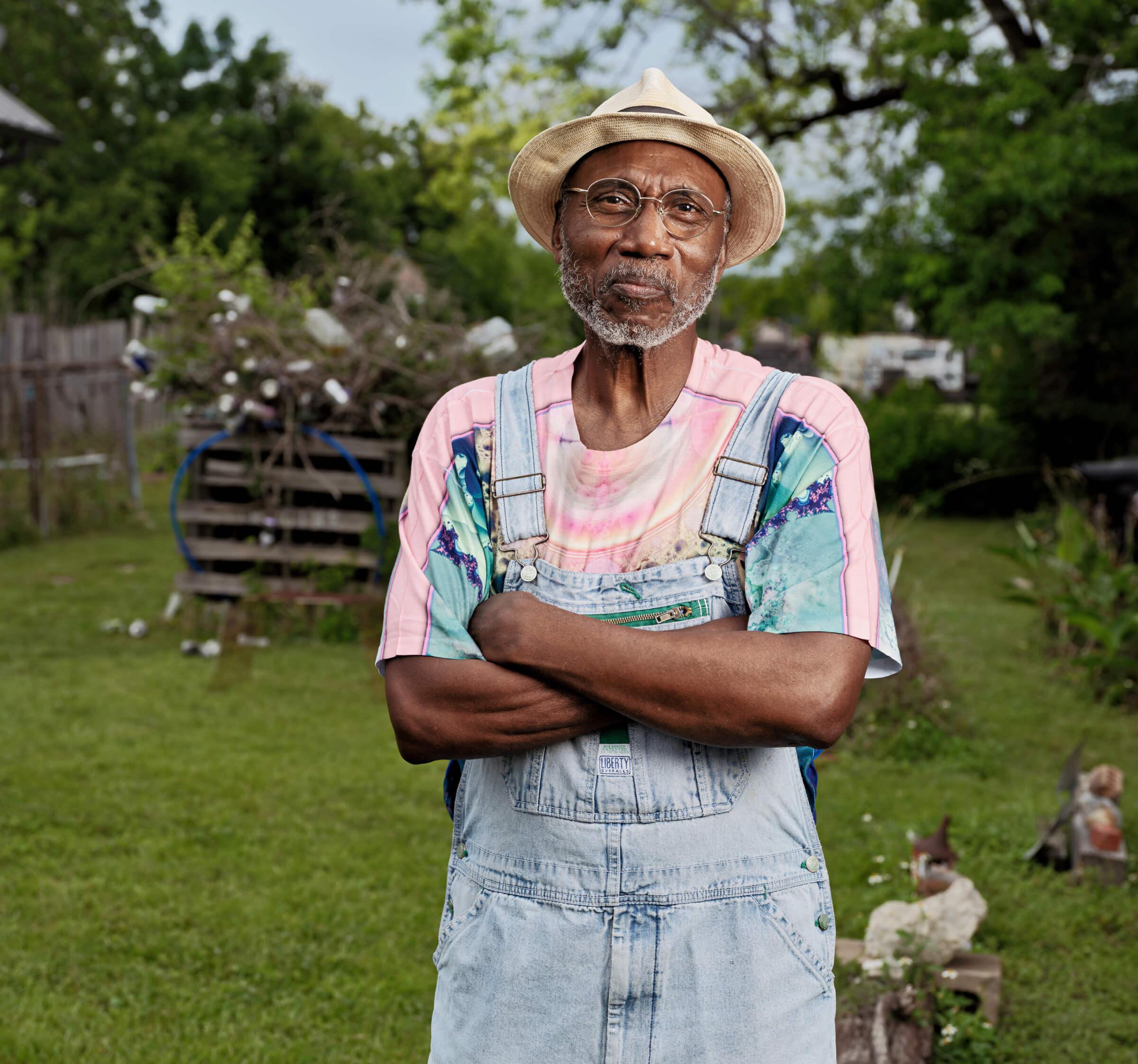
Willie Birch has turned the detritus of Katrina into artwork.
In the Garden of Second Chances
“Everything that’s thrown away, you find another way.”
Willie Birch, 82, renowned artist
AFTER Katrina, some people dug storm drains or put their houses on stilts. Willie Birch couldn’t stop uncovering beauty. When mounds of crawfish from surge waters showed up in his New Orleans backyard, he cast bronze sculptures of their gnarled dwellings as a testament to survival and rebirth. Galleries snapped them up. The same with his large-scale black-and-white silkscreens of storm-flattened buildings and downed power lines that somehow captured the visual poetry of Katrina’s chaos.
Last spring, I met him in his garden of second chances on a tucked-away stretch of the Upper 7th Ward. Birch, whose work hangs in New York City’s MoMA and the Met, is a New Orleans native but could have retired anywhere. After a decade in New York, he returned in the ’90s to New Orleans, bought a broken patch of Old Prieur Street—four crumbling shotgun houses connected by two vacant lots—and made it a living monument to the power of art, memory and community. He’s guided by a lesson from the late Big Chief Allison “Tootie” Montana, a Mardi Gras chief of chiefs: Make your art for the people so when they see it, they feel good about themselves.
Among the wild mustard greens and morning glories, he installed colorful rock sculptures and metal mobiles by fellow artists and built a fence featuring the names of longtime residents of a neighborhood too often left in the margins.
“Somebody came and put a wreath on their mother’s name after she died, so I knew something was working,” he says. Birch’s charcoal drawings of cracked sidewalks and sunken porches make you think twice about what some call urban blight. The money he earns—Birch’s work frequently sells in the tens of thousands—goes almost entirely into a community trust he’s building that ensures his neighborhood haven will serve future generations as an art space and meeting hub.
“People said, “Are you outta your mind investing here?’ ” he says as two kids casually ride by on bikes. Birch waves to them as they slow down to gawk at his sunflowers.“Why would I turn my back on this?”
In the garden, there’s a traditional bottle tree, common among African American communities of the rural South and made from discarded bottles, and broken pecan branches rising from a crate that reads “Imagine.” There’s a ceramic ear in the dirt that, as you look, could also be a swirling storm front. In big gold letters along a wall of rusty chain link is a line Birch’s grandmother often said: “Flowers are for the living.”
All of this is deeply moving. Maybe it’s the idea that ruin can yield seed—and surprise. That you can take crushed soup cans, cowrie shells, broken bricks and bald tires and create meaning. In Birch’s yard, the raw materials of post-storm New Orleans aren’t cleaned up or carted off. They’re the whole point. “Everything that’s thrown away, you find another way,” is how Birch puts it. Even the weeds, he says, are “talking to you—if you know how to look.”
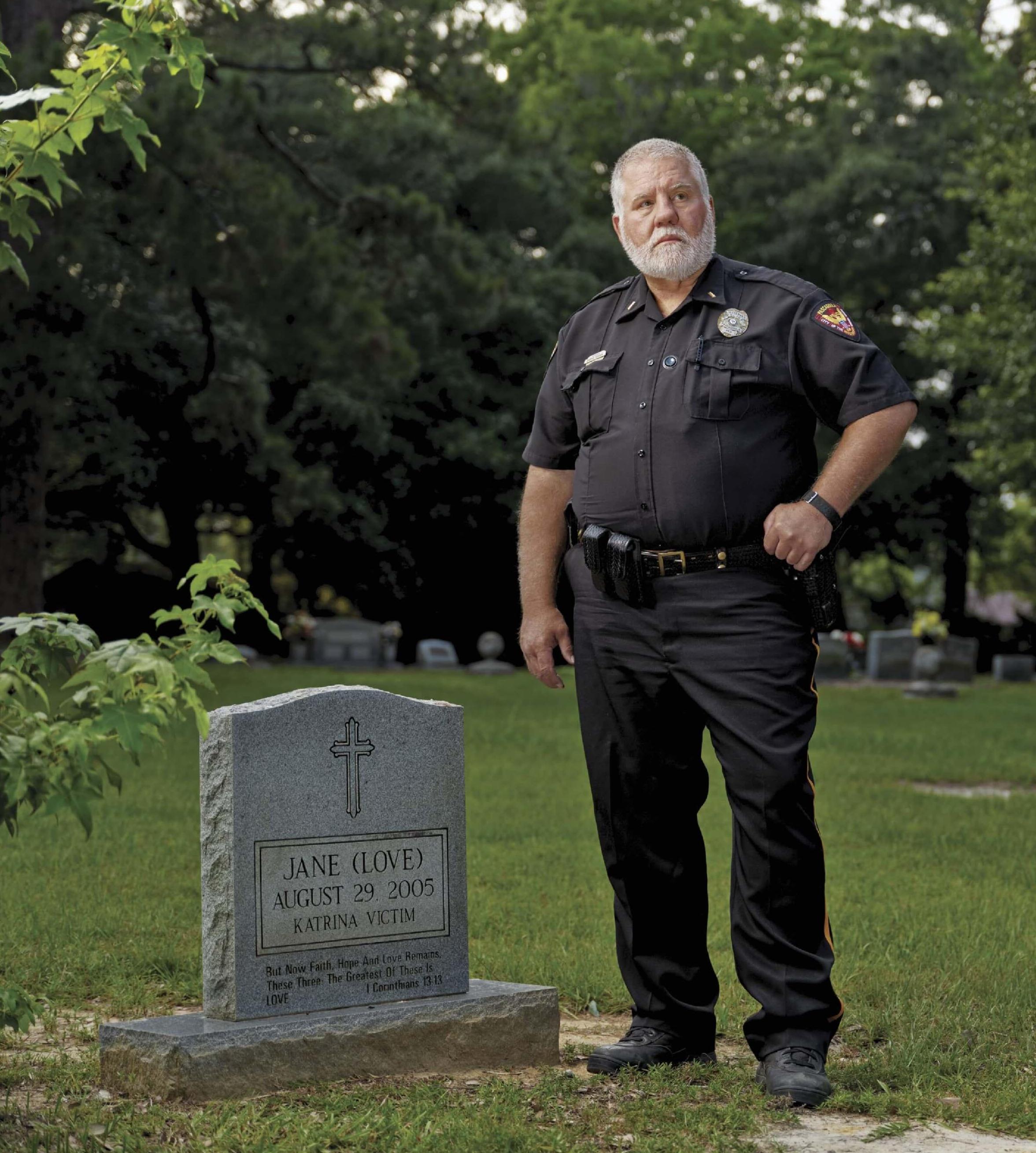
Pascagoula police officer Darren B. Versiga puts names to Katrina’s missing.
Restoring What Katrina Tried to Erase
“The unknown dead deserve their names back.”
Darren B. Versiga, 61, missing persons sleuth
A WEEK AFTER Katrina ripped through Biloxi, Mississippi, the body of a woman was found in the rubble between two homes a few miles from town. Investigators knew the remains belonged to a Black woman, estimated to be between ages 50 and 59, but they could not identify her, so they buried her in nearby Pascagoula under the inscription “Jane (Love), Katrina victim.” The case went cold, like so many others from the storm. While as many as 11,000 people were initially reported missing in the days after Katrina, the vast majority have been accounted for. But estimates today suggest that several hundred were never found.
Even one unsolved case is too many for Pascagoula police lieutenant Darren B. Versiga, who followed the Jane (Love) tragedy from the beginning.
“With this death in particular, I thought, This could have been my child, or my wife or me,” says Versiga, who fled his own flooded home during Katrina and rode out the immediate aftermath for five hours with his wife and their three children clinging to an inoperable Jet Ski.
Around 2010, Versiga began digging deeper into unidentified missing persons cases in his spare time, pro bono. “It haunted me that so many of these lives ended without a proper story or an answer.”
Working alongside DNA experts and others, Versiga helped resolve nine cold cases, unrelated to the storm, with positive IDs. About a year ago, he returned to the unidentified Katrina victim buried in the Machpelah Cemetery. With an infusion of funding from Carla Davis, a philanthropist and genealogist at a Texas forensic genetic genealogy company committed to resolving a backlog of unsolved deaths in Mississippi, Versiga directed experts to exhume the remains. It wasn’t long before the lab identified Jane (Love) as Tonette Waltman Jackson.
That’s when the full human story came into focus. Jackson’s husband had searched and grieved for years. In an interview just after the storm, he described how the floodwaters split their home in two and swept her from his arms. “She told me, ‘You take care of the kids and the grandkids,’ ” he recalled. He kept that promise—until the end of his life in 2013. That same year, her name was quietly added to Biloxi’s Katrina Memorial. Now, nearly two decades since her death, Jackson’s family has her ashes—and some resolve.
“There’s never been a more satisfying moment in my career,” Versiga says. “The unknown dead deserve their names back.”
David Hochman is a longtime contributing editor for AARP The Magazine. His bylines appear in The New York Times, Forbes, GQ, Food & Wine and many other publications.

20 Years of Showing Up
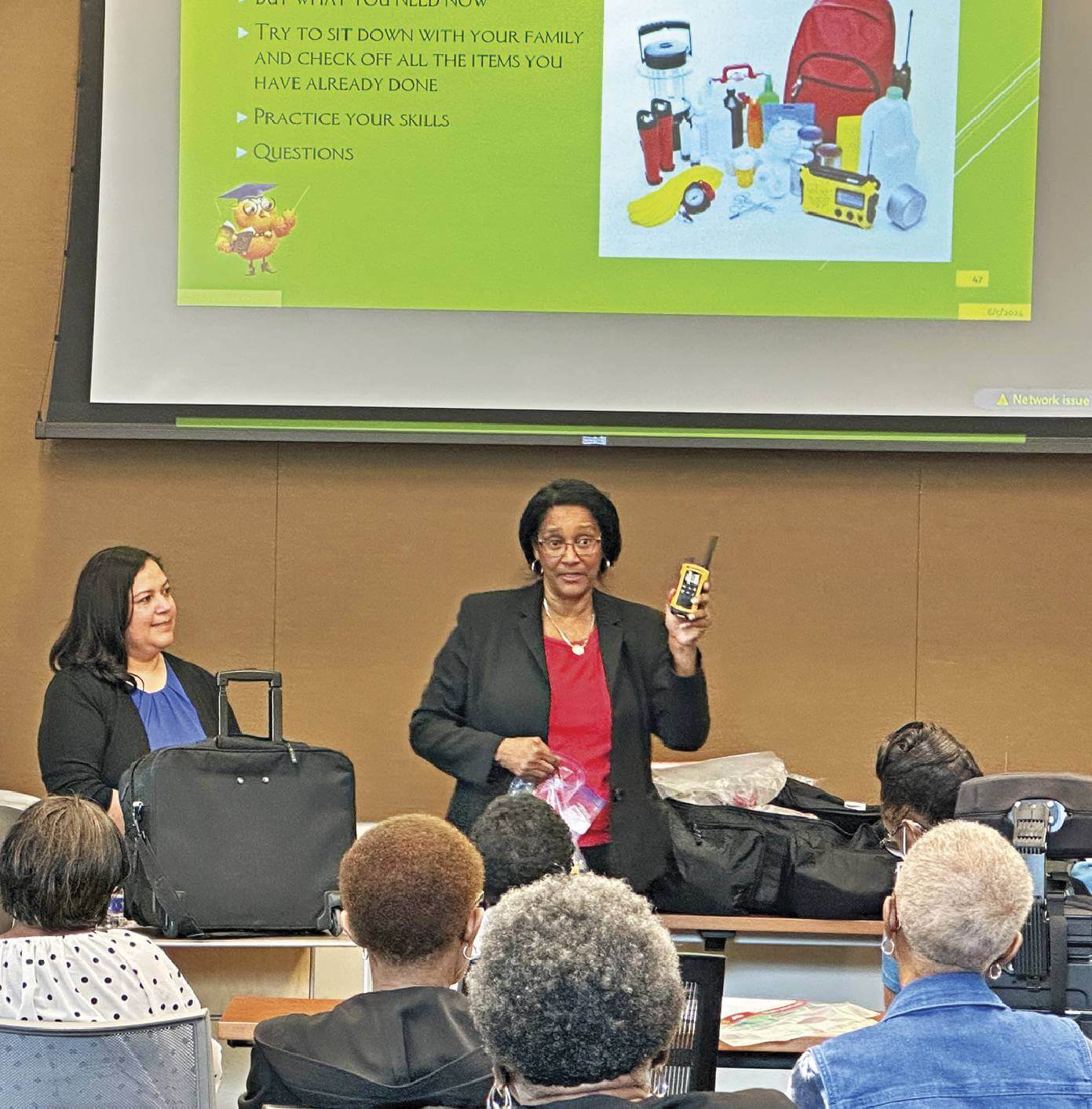
AARP HAS been very active in post-Katrina work in New Orleans and has pushed hard on disaster preparedness for older adults. Some examples:
2006 Hollygrove Livable Communities Project AARP Louisiana partnered with neighborhood leaders to create an “elder-friendly” rebuilding plan in one of the city’s hardest-hit areas.
2022 Disaster Resilience Toolkit (with FEMA) Free guide for local officials on protecting adults 50-plus before, during and after extreme weather.
2024-25 “Be Ready, Stay Safe” Workshops AARP Louisiana’s traveling clinics teach older residents how to build go kits, safeguard meds and store vital documents.
Ongoing AARP Foundation Relief Grants Funding for legal aid, home repair and meal programs for low-income older adults after disasters like Hurricanes Ida and, most recently, Helene.
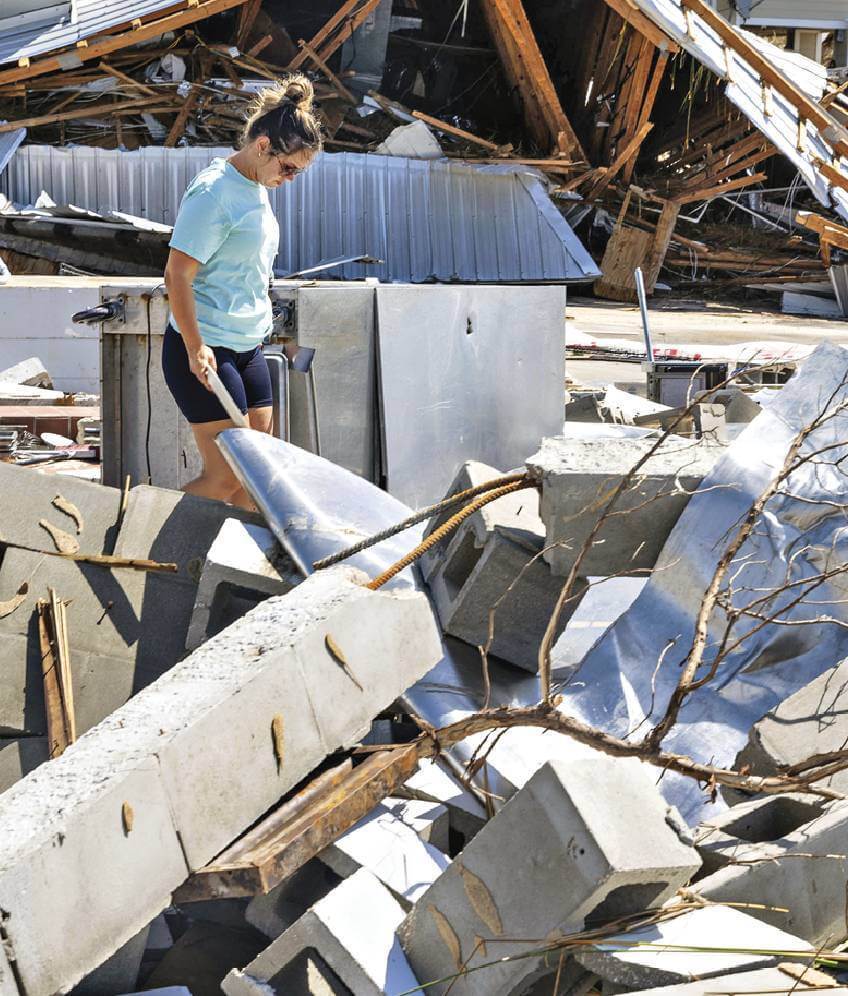
Check out aarp.org/disasterhelp for preparedness checklists and volunteer opportunities.
From top: AP Photo/Eric Gay; David Grunfeld/Tribune News Service via Getty Images; STR New/Reuters/Redux; courtesy Mercy Chefs; AARP; Willie J. Allen Jr./Orlando Sentinel/Tribune News Service via Getty Images.